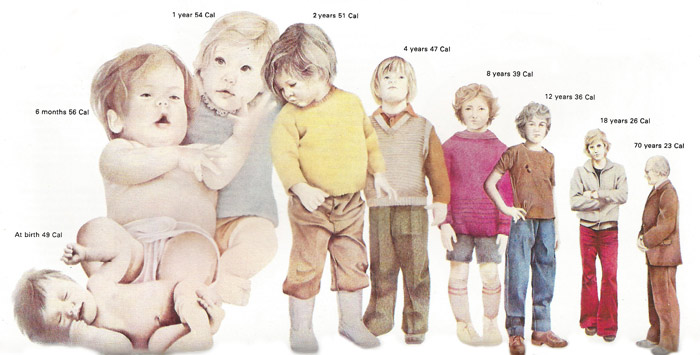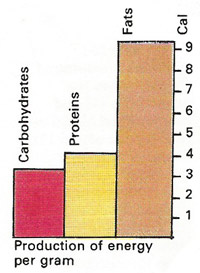nutrition

Certain foods are important sources of carbohydrate (A), fat (B), protein (C), or roughage (D). Except for some refined products like cane sugar, most foods contain several different nutrients. Milk provides carbohydrate, fat, protein, calcium, and some vitamins. Even potatoes contain protein and vitamin C as well as energy-rich carbohydrate.

Simply to keep their metabolism going, children use far more energy per kilogram of their body weight than older people do; they also need much more protein in proportion to their size.

Weight for weight pure fat supplies 2.25 times more energy than carbohydrate. Any protein surplus to the body's need for tissue growth and repair can also supply energy.
Nutrition is the process by which living organisms take in and utilize nutrients – the substances or foodstuffs required for growth and the maintenance of life. Vital substances that cannot be synthesized within the cell and must be present in the food are termed essential nutrients. Organisms such as green plants can derive energy from sunlight and synthesize their nutritional requirements from simple inorganic chemicals present in the soil and air by photosynthesis. Animals, on the other hand, depend largely on previously synthesized organic materials obtainable only by eating plants or other animals (see digestive system; metabolism).
Nutrient groups
Human nutrition involves five main groups of nutrients: protein, fat, carbohydrate, vitamins, and minerals. Proteins, fats, and carbohydrates are the body's sources of energy, and are required in relatively large amounts. They yield this energy by oxidation in the body cells, and nutritionists measure it in heat units called food calories (properly called kilocalories, each equal to 1,000 gram calories). Carbohydrates (food starches and sugars) normally form the most important energy source, contributing nearly half the calories in a well-balanced diet. Cereal products and potatoes are rich in starch; sucrose (table sugar) and lactose (present in milk) are two common sugars. Fats, which provide about 40% of the calories requirement, include butter, edible oils, and shortening, and are present in such foods as eggs, fish, meat, and nuts. Fats consist largely of fatty acids, which divide into two main classes: saturated and unsaturated. Certain fatty acids are essential nutrients; but if there is too much saturated fatty acid in the diet, an excess of cholesterol may accumulate in the blood. Proteins supply the remaining energy needs, but their real importance lies in the fact that the body tissues, which are largely composed of protein, need certain essential amino acids, found in protein foods, for growth and renewal. Protein-rich foods include meat, fish, eggs, cereals,and beans. Too little protein in the diet results in disease of malnutrition such as kwashiorkor.
Minerals (inorganic elements) and vitamins (certain complex organic molecules) provide no energy, but have numerous indispensable functions. Some minerals are components of body structures. calcium and phosphorus, for example, are essential to bones and teeth. Iron in the blood is vital for the transport of oxygen to the tissues; an iron deficiency results in anemia. Milk and milk products are good sources of calcium and phosphorus; liver, red meat, and egg yolk, of iron. Other important minerals, normally well supplied in the Western diet, include chlorine, iodine, magnesium, potassium, sodium, and sulfur. Vitamins, which are present in small quantities in most foods, are intimately associated with the action of enzymes in the body cells, and particular vitamin deficiencies accordingly impair certain of the body's synthetic or metabolic processes. A chronic lack of vitamin A, for example, leads to a hardening and drying of the skin and can result in irreversible damage to the conjunctiva and cornea of the eye. Beriberi is caused by a vitamin B1 deficiency, scurvy by a vitamin C deficiency, rickets by a lack of vitamin D.
Malnutrition
Malnutrition is inadequate nutrition, especially in children, which may involve all or parts of the diet (marasmus), or may be predominantly of proteins (kwashiorkor) or vitamins (pellagra, beriberi, rickets, scurvy). In marasmus, essential factors for metabolism are derived from the breakdown of body tissues; extreme wasting and growth failure result. In adults, starvation is less rapid in onset, as the demands of growth are absent, but similar metabolic changes occur.


